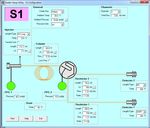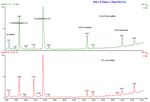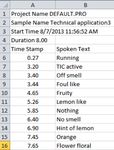GC SNFR Olfactory Port for the Clarus SQ 8 GC/MS
←
→
Page content transcription
If your browser does not render page correctly, please read the page content below
T E C H N I C A L N O T E
Gas Chromatography/
Mass Spectrometry
GC SNFR Olfactory Port
for the Clarus SQ 8 GC/MS
A Complete
Introduction
Solution for Aroma The sense of smell is pervasive to our everyday lives,
enhancing pleasurable experiences, adding to the
Characterization enjoyment of culinary experiences and warning of
possibly unpleasant events with the detection of
off-odors. Many memories are also triggered by smell as the olfactory bulb is
part of the brain’s limbic system. Although odors and scents can be subjective,
understanding what comprises them is increasingly important.
The new GC SNFR™ Olfactory Port enables food, beverage, flavor and
fragrance producers to characterize even the most complex aromas by
capturing sensory evaluation and correlates that human interaction with
analytical data from a PerkinElmer GC/MS system.A Complete Solution Package
The GC SNFR Olfactory Port is the latest addition to PerkinElmer’s
comprehensive suite of innovative gas chromatography solutions
and is seamlessly integrated to a PerkinElmer Clarus® GC, using
Swafer™ technology, and a Clarus SQ 8 mass spectrometer for
best in class sensitivity. By adding the TurboMatrix™ headspace
sample handling option, users have a flexible and convenient
technique to extract and transfer to the GC odor vapors from
samples that cannot be directly injected into the GC column.
Samples such as fruit, coffee, hops, various textiles and petroleum
based materials or those with high water content can easily be
analyzed without complicated extraction steps. The volatile
compounds in the sample matrix are effectively transferred to the
gas chromatograph leaving the heavy bulk of the sample behind
in the sample vial.
With the classical headspace technique, only a very small fraction
of the total vapor is transferred to the GC column. The extraction
performance of the headspace system is further enhanced Figure 2. Nosepiece installed in the GC SNFR Olfactory Port.
through the inclusion of adsorbent trap technology, which
provides efficient compound transport with no condensation.
enables all or most of the sample vapor from the vial to be
The GC SNFR Olfactory Port, shown in Figure 2 has independent
collected, concentrated and transferred to the GC column. This
controls for water temperature and air flow to a maximum of 500
HS Trap sampling system can improve detection limits by a factor
mL/min. Its glass nosepiece is designed to be adjustable in the
of up to x100 and so, very importantly, deliver higher amounts
vertical and longitudinal directions, providing greater comfort
of each compound to the olfactory port to aid their detection by
during long analysis runs. Its nosepiece is easily cleaned with a
the operator.
sanitizing wipe or it can be removed for additional cleaning. Labs
The complete package is shown schematically in Figure 1. can provide each analyst using the system with their own personal
nosepiece for a cleaner, healthier testing environment. The GC
SNFR nosepiece is odor free and designed not to roll should the
user remove it for cleaning.
Figure 3 shows the metal collar of the GC SNFR, which allows an
efficient thermal connection of the nosepiece to the transfer line.
The humidified air is introduced at the base of the collar to
promote an annular flow around the column eluent. Due to these
features, there is no condensation in the nosepiece.
Figure 1. Headspace trap configuration with MS and GC SNFR Olfactory Port.
While no other detectors are shown, it is possible to add further
detector options, up to a maximum of two, in the GC in addition
to the MS and SNFR port.
GC SNFR Olfactory Port
The GC SNFR Olfactory Port is a device that allows a fraction of
the GC column effluent to flow through a narrow transfer line
and be presented through a nose piece to the operator's nose. In
this way, it’s possible to monitor the smell of compounds as they
elute from the GC column at the same time as they are processed
by the MS and other detectors that may be present. This provides
a very powerful means of correlating analytical data with sensory
perception – simultaneously getting both an objective and a
subjective interpretation of sample aromas. Figure 3. GC SNFR metal collar with nosepiece removed.
The GC SNFR system consists of a heated silica transfer line from
the GC, which provides an inert path from the column to the
nosepiece. The eluent is then mixed with humidified air at the
inlet to the glass nosepiece to prevent drying of the nasal
passages during prolonged monitoring. A concentric airflow
2Swafer Technology
Swafer™ technology is a flexible micro channel device for heart-
cutting and split flow manipulation. The GC SNFR Olfactory Port
uses the S-Swafer as a post column splitting device to distribute
the effluent from the column at a constant pressure. This provides
a stable flow of gas into each detector and the GC SNFR Olfactory
Port. The addition of a second pressure source regulates the
splitting and maintains the outlet flows independent of column
head pressure. Independence from column head pressure
increases the options available to a chemist with respect to flow
rate in the separation as there is no requirement that the column
flow also satisfies the detector flows. Split ratios and flows are a
result of the selected transfer line geometries to each detector and
the GC SNFR Olfactory Port and carrier gas pressure.
The chromatographic separation is critical from an identification
standpoint and from the human interaction. If the compound
resolution is too close, then individual identification may be Figure 5. Swafer utility software demonstrating the effect of tubing dimensions
a challenge. on flow note column head pressure of 40 psi(g).
The Swafer configuration allows manipulation of the column flow
rate and separation without impacting the active split between
the mass spectrometer and the olfactory port.
Figure 4 shows a test mix of compounds separated initially with
a constant pressure method and then with a ramped pressure
method. The mixture was a liquid injection on to a 30 m x
0.25 mm x 0.25 micron wax column. The timing between the
MS and response to the olfactory port was unchanged between
the two methods.
Figure 6. Showing an increase in carrier head pressure having no effect on the
split ratio between the MS and GC SNFR Olfactory Port.
Figure 4. Constant and ramped pressure experiments.
The selection of split ratio is heavily dependent upon the sample
composition because of the difference in sensitivity between the
The difference in chromatography can be observed in this
MS and human olfactory bulb. It is entirely possible that very
example by the shift in retention time and the elution of vanillin in
strong smelling compounds to which an analyst is very sensitive
less than 41 minutes.
may be detected at extremely low concentrations and possibly at
The Swafer Utility Software is helpful in identifying the tubing levels close to the detection limit of the MS. In such cases it is
dimensions for the desired split control. obviously desirable to have a very low split ratio (possibly less than
one and in favor of the MS).
The GC SNFR Olfactory Port has demonstrated excellent
performance with heavy musk compounds and vanillin, which
were easily detected with no delay or condensation on the
nosepiece. The timing between the nosepiece and MS is virtually
simultaneous, enabling excellent correlation between analyst scent
exposure and MS peak detection for accurate determination. The
chosen silica dimensions provide simultaneous detection between
the nosepiece and MS, enabling excellent correlation of the data.
3TurboMatrix Headspace Trap
Sample Handling System Software Interaction
The TurboMatrix headspace trap system is an effective way The GC SNFR Olfactory Port Narrator software is directly linked
to collect odor samples without complicated extraction to the TurboMass™ software to ensure data continuity. As
procedures. Most importantly, the TurboMatrix will only shown on a typical screen in Figure 8, the audio input is
sample those compounds that are present in the headspace displayed with an active text box that transcribes the user
for aroma characterization and will not extract non-gaseous narration. Also note the intensity chart, which captures input
compounds from the samples that may not be contributing to of the perceived odor intensity.
the odor experienced.
Three musk compounds were analyzed with a Tenax TA trap:
α-hexyl cinnamaldehyde, hexamethyltetralin and Galaxolide. The
headspace conditions for the total evaporation experiment are
given in Table 1.
Table 1. Headspace conditions for total evaporation experiment.
Headspace System TurboMatrix 110 HS Trap
Vial Equilibration 210 °C for 15 minutes
Needle 210 °C
Transfer Line 210 °C, long, 0.25 mm i.d. fused silica
Carrier Gas Helium at 40 psig
Dry Purge 5 min
Trap Tenax C, 30 °C to 300 °C, hold for 5 min
Extraction Cycles 1 with 40 psig extraction pressure
The results shown in Figure 7 demonstrate the efficient transfer
of these heavy base musk compounds from the Tenax TA trap
through the heated transfer line to the analytical column and the
MS and GC SNFR detectors.
Figure 8. GC SNFR Olfactory Port Narrator software recording text and
intensity. Both records are readily displayed on the obtained chromatogram
for ease of reference with audio playback available as required.
An analog joystick is provided for intensity measurement input
that is then overlaid on the total ion chromatogram (TIC). The
overlay enables the analyst to focus identification and analysis on
those areas of the TIC that have the greatest odor impact.
The GC SNFR Olfactory Port Review software overlays a graphic
Figure 7. Musk compounds extracted as part of a total vaporization experiment depicting both the audio stream and the intensity data. Figure 9
with headspace trap technology. shows an example. Sections of the recorded narration may be
re-played by mouse-clicking on the audio stream graphic.
The musk compounds were efficiently transported through the
headspace transfer line at 210 °C.
Liquid injections are also possible for essential oils or organic
extracts in accordance with standard GC practice.
Environmental samples can be sampled using a thermal
desorption tube and then injected with a TurboMatrix thermal
desorption system.
Figure 9. Chromatogram with audio overlay.
4Export of the data in the form of a comma separated value The audio recording can optionally be transcribed into a text
(CSV) file into a software application such as Microsoft® Excel® stream and stored into a CSV file (Figure 12) for ease of reading
as shown in Figure 10 is also a simple task. The advantage of and exporting to Microsoft® Excel®, Word® or any other suitable
exporting the data is that it is possible to combine the perceived software package. This is achieved through the use of the Nuance®
experience of multiple analysts to calibrate their sensitivity to a Dragon® Naturally Speaking software, which is called from the GC
particular compound. Alternatively, the perceived odor intensities SNFR Olfactory Narrator software, which is included in the GC
can also be overlaid in parallel to form a panel of experience from SNFR system.
multiple analysts.
Figure 12. Transcribed text ready for export or reference.
Applications
The GC SNFR port is very well suited to fragrance analysis as
Figure 10. Excel® export of perceived intensity versus time. demonstrated by the data in Figure 7 with the musk bases’
efficient transport and detection. The musk compounds
Once the data is loaded into Excel®, it can be easily processed demonstrate the mass range of the system application (Galaxolide
and formatted to suit the reporting requirements of the user. with a boiling point of 304 °C) and are an important benchmark
Figure 11 shows an example in which data is presented graphically. for the system application as they are somewhat ubiquitous in
laundry detergents, perfumes, cosmetics and other artificially
scented products.
Natural products are also readily analyzed with other
applications:
• Whisky
• Hops
• Beer
• Coffee
• Food
The purpose of the analysis can be for a number of reasons
including the following:
• QC check of raw ingredients
• QC check of final product
• Reverse-engineering competitive products
• Product development
Figure 11. Overlay of diluted and full strength standard showing perceived
change in odor intensity. • Off-flavor analysis
• Storage studies
The following pages show a few examples of typical applications.
5Figure 15 shows a chromatogram of an alternative hop variety,
Fuggles, from the Cascade hops shown in Figure 14. The
information obtained from the GC SNFR olfactory port enables
correlation between the user aroma experience with the
qualitative and quantitative data obtained from the mass
spectrometer. Decisions related to flavor and balance can then
be more quickly and accurately determined.
Figure 13. Off-odor investigation of beer.
Figure 15. Chromatogram of Fuggles hops.
An additional application investigated how the addition of water
changed the aroma of whisky and the resulting consumer
experience. Figure 16 describes the change in the headspace
concentration of a malt whisky sample with the addition of 1 ml
of water. Not only were the ester compounds that are
characteristic of whisky enhanced in the headspace but the
Figure 14. Cascade hops investigation. alcohol concentration is reduced. It is important to realize the
depressive impact on the sense of smell that alcohol has in a spirit
The investigations into beer and hops were part of an ongoing that is 40% alcohol by volume. The addition of water therefore
quality assurance effort to characterize finished product and to has a twofold effect on the compounds in the headspace in that it
source alternative raw materials. The evaluation of hops also lends minimizes the depressive alcohols while at the same time
itself quite nicely to the development of new beer. enhancing the concentration of the desired aroma compounds.
Figure 16. Effect of water on characteristic aroma compounds in whisky.
6However, the GC SNFR Olfactory Port is not limited to food Summary
products only. Off odors are commonly found in the environment, PerkinElmer’s GC SNFR Olfactory Port is designed for high quality
packaging materials and polymer based materials used in shoe performance, comfort and ease of use. Integrated with the
construction, for example. Odor investigations on large volume PerkinElmer GC/MS system, the GC SNFR Olfactory Port enables a
locations can be achieved by sampling and trapping with a clear, complete profile of food, beverage and fragrance samples.
thermal desorption tube prior to analysis in a similar system by
replacing the TurboMatrix headspace trap with a TurboMatrix The system’s column flow independence allows great variety in
thermal desorption system. analytical methodology as the detector gas input is independent
of the flow through the analytical column. Sample introduction
is compatible from liquid/liquid extraction, headspace, headspace
trapping to thermal desorption of large volume spaces. Timing
of the scent arriving at the nosepiece and MS detector is
simultaneous for accurate odor determination and all sensory
inputs are recorded and catalogued with analytical data for
data continuity.
PerkinElmer, Inc.
940 Winter Street
Waltham, MA 02451 USA
P: (800) 762-4000 or
(+1) 203-925-4602
www.perkinelmer.com
For a complete listing of our global offices, visit www.perkinelmer.com/ContactUs
Copyright ©2014, PerkinElmer, Inc. All rights reserved. PerkinElmer® is a registered trademark of PerkinElmer, Inc. All other trademarks are the property of their respective owners.
011493_01You can also read



























































